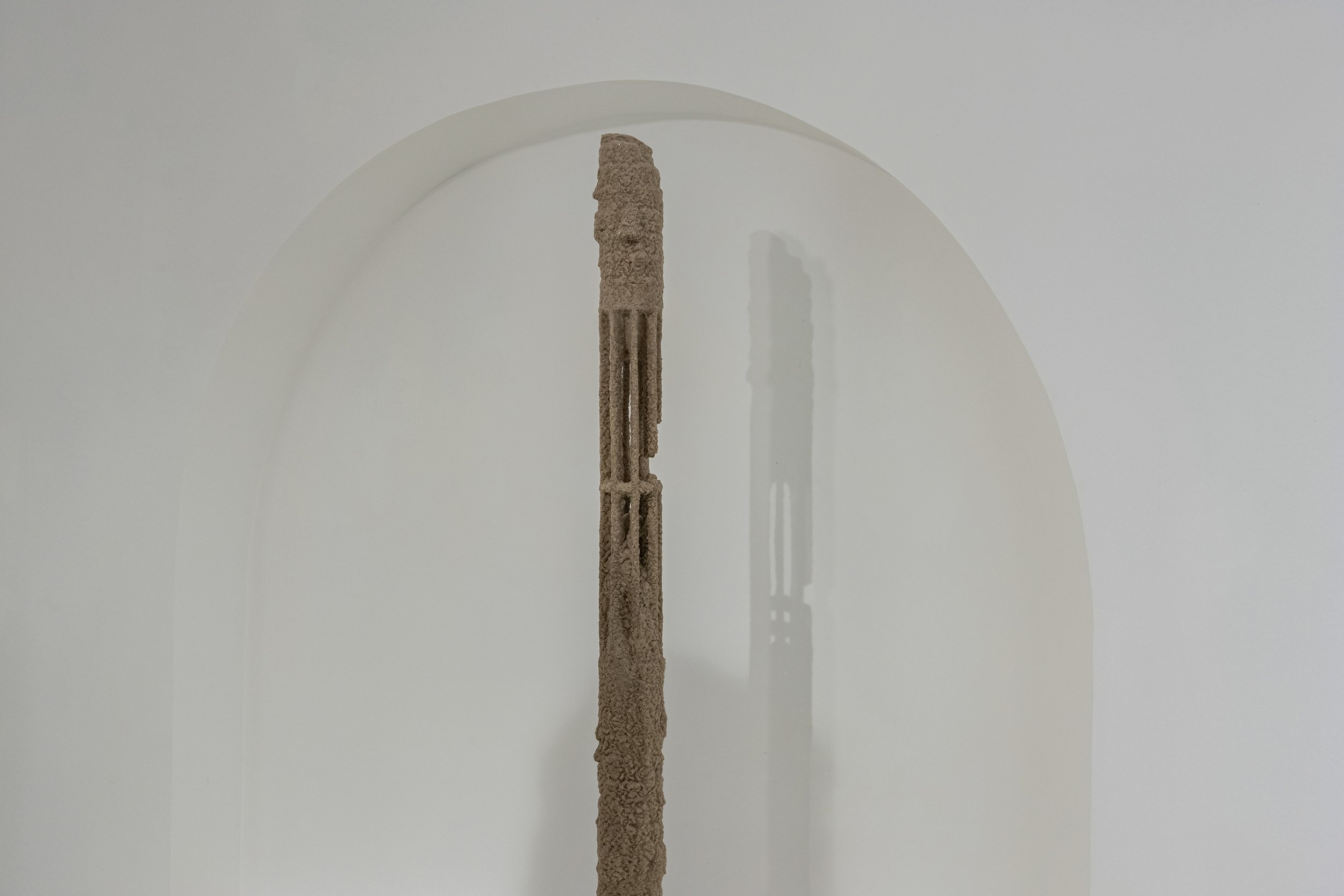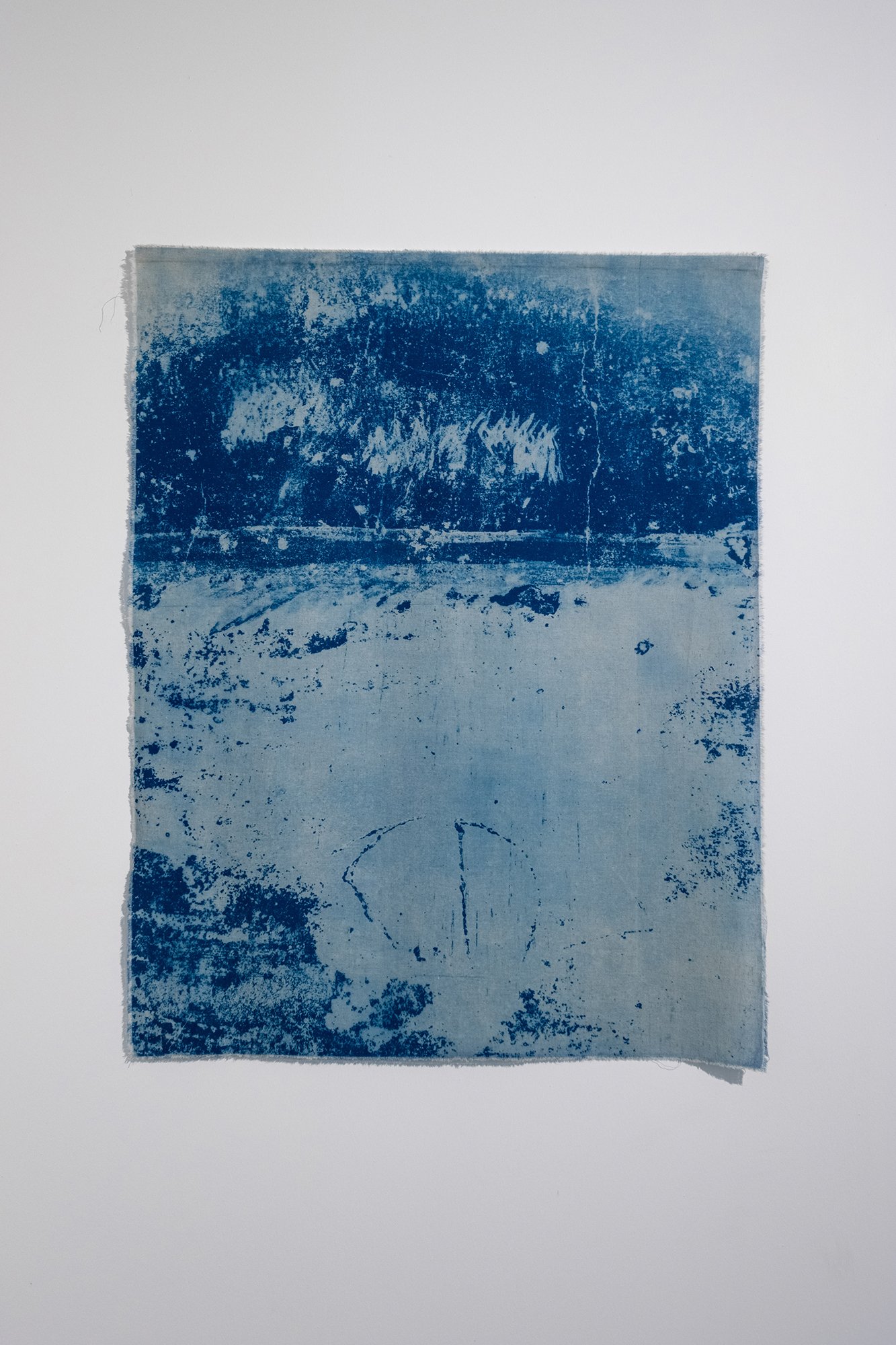Acima do Chão, by Tiago Rocha Costa
24th June — 29th July 2023
The ground is the place from which a vital force springs, the source from which everything departs and to which everything returns. Our past is revealed through the traces left by others and the evidence of our identity.
Let’s start by looking for a trace in the very definition of “ground” — “a surface that, due to its relative extension and homogeneity, can be walked on and serve as a base or support for things; coated ground or underside of a building; pavement; flat surface; Earth”. Various derivations and meanings of the word share as a common denominator the concept of base, support, and foundation. ‘Chão’ (ground) is configured as the support from which life is born, and an upward movement of devotion and liberation is associated with it. As a territory, it impregnates us with a genetic code that connects us to itself and shapes us in many different ways. We are the fruit of the ground from which we grow.
I met Tiago in one of the first weeks of opening Plato. We spoke briefly, exchanged emails and I asked if I could see his work. It was one of the works that most excited me in recent times, making me immediately seething with ideas and imagining various potential exhibitions. As soon as I saw Tiago’s work, I was amazed by his ability to bring together references from both a scientific and a fictional universe. It was later revealed to me that he was fascinated with dinosaurs and birds, demonstrating an innate need to understand reality objectively. His works confront us with different new narratives and thus allow us to understand the world with a new objectivity. He works with his imagery repertoire, focusing on nature, one of the central themes of his work and which, over time, is constantly revisited and reconstructed.
His practice is multidisciplinary and open to various interpretations, thus evoking the poetics of Umberto Eco’s open work. He questions nature above all but is devoid of any romanticism. It portrays, in turn, a domesticated, controlled, entropic nature. His work addresses concepts such as symbiosis and coexistence of species, ruin, vestige, and extinction. The vestige, as a document of the past, constitutes the raw material for the artist, an invitation not only to understand it but also to see the potential of what it could become. He could be identified as a “plastic archaeologist” who assimilates the plasticity of the materials used (mostly of a daily or industrial nature) to reconfigure new traces of new realities, which may or may not happen. It leaves us with devices endowed with an enormous critical capacity for what has passed and what is yet to come.
In the exhibition, three moments coexist, with individual narratives that interconnect and contaminate each other. In the first room, we are invited to enter an unknown urban system, invoking a certain presence of Calvino in the symbolism it conveys. Fourteen columns of Saturn sprout from the ground in an upward movement, interspersed with attempts to reach a higher plane. Arranged like megaliths, they form a constellation that leads the viewer to penetrate another architectural nature. We are left with the testimony of the genius loci of an indefinite place and time. They are ruins of a time that is not necessarily ours.
The second moment of the exhibition reflects on the ground, on the land as a space established by power relations and the weight of existing physical and social boundaries. In the 1970s, more precisely in the Verão Quente of 1975, a group of visual artists created a wall in Jardim dos Colegiais, in Évora, which celebrated the break with the old regime and the consequent achievement of Agrarian Reform. The mural, over the years, was slowly invaded by nature and, today, few fragments of it remain. From the traces of the mural were born six cyanotype fragments that reinterpret the original, recreating a new geography in the exhibition space. Based on the concepts of vestige and territory, a dialogue is established here with fragments close to the past — imagined, recreated, evoked, or appropriated — questioning its borders.
The last moment takes us to Fim de turno, produced in 2021, as part of a project with the mining town of Lousal. The work traces back to the beginning of the exhibition, working with the same compositional logic, now on a more human scale. Here, the various readings of the ground merge, from a geological point of view, concerning the soil and matter that composes it, and from an anthropological point of view, evoking the characters that inhabited it.
Each of these moments is markedly illustrative of Tiago Rocha Costa’s vision and work process, endowed with a rigor close to the scientific and a plasticity that originates multiple narratives. With the analysis of the territory where he “digs,” he tries to find a fragment of himself here, which could constitute his own identity.
Colunas de Saturno, 2023 / Quartz sand, river sand, ash, pigment, mdf and extruded polystyrene / Variable dimensions
Colunas de Saturno, 2023 / Quartz sand, river sand, ash, pigment, mdf and extruded polystyrene / Variable dimensions
Colunas de Saturno, 2023 / Quartz sand, river sand, ash, pigment, mdf and extruded polystyrene / Variable dimensions
Colunas de Saturno, 2023 / Quartz sand, river sand, ash, pigment, mdf and extruded polystyrene / Variable dimensions
Dia de Festa I (after codice), 2023 / Cyanotype on linen and cotton fabric / 78 x 74cm
Dia de Festa II (after codice), 2023 / Cyanotype on linen and cotton fabric / 43 x 33cm (diptych)
Colunas de Saturno, 2023 / Quartz sand, river sand, ash, pigment, mdf and extruded polystyrene / Variable dimensions
Colunas de Saturno, 2023 / Quartz sand, river sand, ash, pigment, mdf and extruded polystyrene / Variable dimensions
Toby (after codice), 2023 / Cyanotype on linen and cotton fabric / 112 x 165cm
Exhibition View
Debaixo do Céu (after codice), 2023 / Cyanotype on linen and cotton fabric / 28 x 32cm
Lascaux (after codice), 2023 / Cyanotype on linen and cotton fabric / 76 x 56cm
Acima do Chão (after codice), 2023 / Cyanotype on linen and cotton fabric / 90 x 70cm
Colunas de Saturno, 2023 (detail) / Quartz sand, river sand, ash, pigment, mdf and extruded polystyrene / Variable dimensions
Colunas de Saturno, 2023 (detail) / Quartz sand, river sand, ash, pigment, mdf and extruded polystyrene / Variable dimensions















